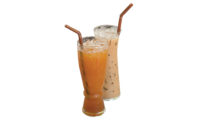After seeing declines year after year, the milk category (at least at retail) now seems to be pulling rabbits out of a hat. Dollar sales in the overall category rose 7.8% to $16,330.1 million during the 52 weeks ending Sept. 6, 2020, according to data from Chicago-based market research firm IRI. Unit sales increased 1.5% to 5,574.7 million.
Meanwhile, the refrigerated whole-milk subcategory wielded some magic dust to outperform the larger category. Dollar sales in the segment jumped 10.2% to $5,358.0 million, while unit sales climbed 4.0% to 1,772.2 million.
Milk | Cheese | Cultured | Ice Cream | Butter | Non-dairy Beverages | Ingredients | Exports
Even the long-suffering skim/low-fat milk subcategory had some tricks up its sleeve. Dollar sales in the segment rose 5.1% to $7,292.2 million. But unit sales took a 1.7% dive to $2,507.2 million.
And the refrigerated flavored milk/eggnog/buttermilk subcategory had some hocus pocus on its side, too. Dollar sales in the segment increased 3.1% to $1,564.2 million. However, unit sales fell 2.7% to 650.9 million.
Pandemic conjures up interest
The coronavirus pandemic can take some of the credit for milk’s magic act at retail.
“Early in the year, when the country began to shut down in response to the pandemic, we saw consumers flock to the stores and stock up on nutritious foods like milk and dairy,” notes Monica Massey, executive vice president and chief of staff of Dairy Farmers of America (DFA), Kansas City, Kan. “And while foodservice and school milk have taken a hit this year, with more families preparing meals at home, we saw increased sales of milk at grocery stores early on. And now retail milk sales remain fairly steady.”
For its part, the Washington, D.C.-based Milk Processor Education Program (MilkPEP) has seen some shifts in the types of milk consumers are choosing amid the pandemic, says Yin Woon Rani, MilkPEP’s CEO.
“Consumers are reaching for more and different types of milk,” she notes, citing significant dollar sale increases for whole milk, organic milk and valued-added milk, in particular.
Presto chango
Speaking of value-added milk, it’s the kind of innovation that is also bringing consumers back to the milk category. Consumers are seeking out foods and beverages that not only have a great taste, but also deliver meaningful, relevant benefits, says Domenic Borrelli, president of premium dairy and plant-based foods and beverages for Danone North America, headquartered in Broomfield, Colo., and White Plains, N.Y.
“At Danone North America, we are committed to growth with a focus on premium value-added dairy milk offerings,” he says. “For example, we recently introduced Horizon Organic Growing Years, a milk catered specifically to children 1- to 5-years old.”
The milk was developed in partnership with pediatricians, Borrelli explains. Each 8-ounce serving contains not only 50 milligrams of DHA omega-3 to help support brain health, but also probiotics and choline, which helps transport DHA in the body.
“Early results have been very positive from consumers,” he adds.
Massey agrees there is high consumer interest in milk with a little something extra.
“We’re seeing continued interest in functional foods or those that offer additional nutritional or performance benefits such as probiotics or added protein,” she points out. “As an example, this fall our Kemps brand is pilot-testing a new product, Siips, a high-protein flavored milk in a can with a lowered sugar content, which is targeted at tweens and teens. We think this innovation, both packaging and product formulation, is a promising area for fluid milk growth.”
Seattle-based Darigold Inc. was aiming for a higher protein content, too, when it launched the Darigold FIT line last year. The line’s offerings have 75% more protein and 40% less sugar than “regular” whole milk and were introduced in response to consumer demand for better-for-you products, says Duane Naluai, president of Darigold consumer products.
“We believe dairy products from local Northwest family farmers sit at the intersection of these consumer needs,” he adds. “Consumers want products that nourish the body and soul while doing what is right for the planet — and innovation like our aseptic bottling line for FIT is helping us respond to those needs. Bottling our milk through an aseptic system gives our products a longer shelf life, and this decreases food waste.”
Phoenix-based Shamrock Farms, meanwhile, recently launched Shamrock Farms Rockin’ Protein Plus. The ready-to-drink milk-based beverage offers the advantages of anti-inflammation and antioxidants from real fruit juice and natural protein from milk, the company says. It comes in two flavors: Cherry Crème and Blueberry Pomegranate.
And DFA brought yet another value-added product to market recently with the launch of its Live Real Farms milk blends. The products combine cow’s milk with plant-based ingredients such as almond and oat.
“While the product is ultimately rooted in real wholesome milk, it gave us an opportunity to fulfill a need and provide a unique taste experience for consumers who might be exploring other beverage options,” Massey says.
Sleight of hand brings flavor innovation
On-trend flavors are adding excitement to the milk category, too. Moreover, when it comes to flavored milk formulation, there’s increasing consumer demand for whole-milk varieties, Rebecca Leinenbach, vice president of marketing and communications for Edwardsville, Ill.-based Prairie Farms Dairy Inc., says.
“In fact, within Prairie Farms, whole chocolate milk now holds the top spot in sales within the category,” she points out. “This prompted us to expand our premium chocolate milk size lineup to include a UHT half gallon. Because of the longer shelf life, the chocolate UHT half-gallon milk has extended our distribution reach to the West Coast.”
Like many other milk producers, Prairie Farms has also seen success with limited-edition, seasonal flavored milk offerings. For example, the cooperative introduced Easter Egg Nog, Orange Crème, Strawberry Crème and Chocolate Marshmallow as its spring 2020 milk flavors — and brought back Chocolate Custard, Leinenbach says.
“Chocolate Custard is also back for fall 2020 and joins other tried-and-true Prairie Farms holiday favorites,” she adds.
For its part, Dallas-based Borden Dairy released three limited-edition State Fair of Texas-inspired milk flavors, including Cotton Candy, Caramel Popcorn and last year's blue ribbon winner — Banana Taffy — this summer. The products retail in 16-ounce plastic bottles.
"While we can't all be together in person to enjoy all the famous food of the state fair, families can still enjoy the fair's fun and indulgent flavors in their homes when they try Borden's unique milk flavors," says Pete Schenkel, Borden board member and former chairman of the State Fair of Texas.
This fall also saw the introduction of Oakhurst Maple milk from Oakhurst Dairy, a wholly owned subsidiary of DFA. The limited-edition milk is made with 100% pure maple syrup the Portland, Maine-based company sources locally — from Bascom Family Farms of New Hampshire.
In addition, DFA’s Kemps brand recently launched the limited-edition Pumpkin Spice Holiday Nog, Massey notes.
When it comes to flavors that resonate with today’s consumers, processors might want to avoid some of the more unique flavors trending in other beverage categories, Laura McBride, director of innovation for Organic Valley, and Meenakshi Trehan, vice president of brand marketing and innovation for the La Farge, Wis.-based cooperative, suggest.
“Consumers now more than ever are looking for familiar, nostalgic flavors they grew up with,” they say.
Packaging, sustainability work their magic
New packaging, too, can take some credit for bringing consumers back to the milk category. For example, Kinderhook, N.Y.-based Maple Hill Creamery LLC introduced single-serve, shelf-stable milk products under the Maple Hill Organic brand in late 2019.
“It’s the first 100% grass-fed organic aseptic milk in the United States,” explains Carl Gerlach, CEO of Maple Hill Creamery. “The package eliminates the straw, which creates sustainable packaging and an overall more sustainable product. The resealable cap allows parents to reseal the milk box when on the go and also allows for multiple uses, preventing waste.”
Massey says DFA believes a lot of opportunity can be found in innovation tied to more sustainable and convenient packaging.
“At DFA, we’re continuing to make investments in plants, products and packaging with the development of more aseptic and extended-shelf-life products, which we think will help meet consumers’ needs,” she says.
Speaking of sustainability, today’s consumers want to know that the products they buy “can also be good for the planet,” Borrelli maintains.
“In particular, consumers are starting to ‘vote’ for sustainability with their purchases, and we know that they have placed a heightened importance on the food they eat and its impact on the planet,” he says. “In fact, 71% of U.S. consumers today consider sustainability in their purchasing decisions,” he adds, citing 2019 data from the Hartman Group.
For its part, the Horizon Organic brand introduced The Horizon Next Frontier Project, which Borrelli says “aims to go beyond organic standards to deliver high-quality dairy products” while respecting the environment at the same time. As part of the initiative, the brand committed to becoming carbon-positive by 2025.
Darigold made a similar commitment — to be carbon-neutral by 2050, Naluai says. The commitment will be a significant driver of future innovation for the company in milk and other dairy categories.
“The path to becoming carbon-neutral will drive dairy — and Darigold — to invest in projects to combat climate change, designing and marketing new packages and products that will nurture the lives of our farmers, customers, consumers and the precious planet we all share,” he says.
The commitment also means Darigold is looking at packaging innovation that will reduce waste, Naluai explains.
“Our new aseptic shelf-stable capabilities will allow us to reduce energy usage in the supply chain, and we have redesigned our secondary packaging to also reduce use of materials by 50%,” he says.
Darigold and the cooperative it serves as its marketing and processing arm — Northwest Dairy Association — also are founding members and signatories of the U.S. Dairy Stewardship Commitment, Naluai adds. That commitment affirms their multi-generational stewardship principles for protecting and caring for their communities, animals and the environment.
Avoiding a disappearing act
As milk processors look to keep the momentum going, they do face a number of challenges. One major challenge outside the retail arena is the disruptive force the pandemic is playing on foodservice and school lunch programs.
“Managing school milk programs has been challenging, particularly with the uncertainty of schedules and hybrid programs,” Massey admits.
Even as many children have been returning to school, milk in the two most popular fat levels — whole and 2% — is not yet an option, Leinenbach points out.
“Now is the time to hold on [to] future generations of milk drinkers,” she emphasizes. “Prairie Farms will continue to advocate for USDA to remove restrictions from the National School Lunch and Breakfast programs on which types of milk schools can offer.”
Another challenge is the overwhelming number of choices within the beverage universe, says McBride and Trehan.
“Macro trends have led to attitudinal shifts, including the eroded healthiness perceptions of milk,” they add.
Massey stresses that it is important for milk processors to challenge themselves to remain relevant and invest in innovation that “appeals to the wants and needs of today’s consumers.”
The growing popularity of plant-based milk alternatives certainly poses a threat to many milk producers as well, Gerlach says.
“However, Maple Hill Creamery sees these products as a complement to our portfolio and not a challenge,” he says. “There are a lot of households with both plant-based alternatives and Maple Hill milk products in the fridge to meet different dietary preferences or needs. We are complementary in that Maple Hill and plant-based alternatives have a shared mission of sustainability and healing the planet.”
For Horizon Organic, continuing to reinforce the value of organic remains a challenge, Borrelli notes.
“The reality is not all milk is created equal,” he says. “That’s why Horizon is committed to leading by example and not only upholding the USDA organic standards we helped create, but also continuing to push and evolve our corporate standards as our world changes. With additional independent claims like Non-GMO Project Verification or Animal Welfare Certified, the organic category needs to reassert its unique advantage to consumers with all that it encompasses.”
For the time being, at least, keeping up with the increased demand at retail also poses a challenge.
“At times, particularly during the onset of the pandemic, massive demand for fluid white milk caused our manufacturing facilities to shift gears to produce only gallons of white milk — running around the clock some weeks,” Leinenbach says.
No crystal ball
Looking ahead, Leinenbach stresses that what the “new normal” will look like is uncertain.
“However, consumers have indicated that they will continue to eat and cook at home,” Leinenbach says. “We see opportunities to keep milk top of mind with families by promoting the value and health attributes of milk.”
In the meantime, Prairie Farms will continue to provide meal-planning solutions featuring comfort food recipes that are rich in dairy. The cooperative also sees opportunity in at-home beverages such as milk-based iced coffees that replace what consumers purchased at coffee shops and fast-food outlets pre-pandemic.
Child nutrition will continue to spell opportunity, too, Borrelli predicts.
“A child’s nutritional needs are not the same as those of an adult, and their food options need to reflect that important difference,” he explains.
“Unexpected” dairy solutions hold appeal as well, Gerlach suggests.
“There has been a lot of new innovation in plant-based alternatives, and dairy milk is ready for a breakout innovative product,” he says.
The right marketing will be critical, too, McBride and Trehan note.
“Milk is still a powerhouse category. We’re focused on a multifaceted approach, including opportunities to develop compelling messaging in and outside the store,” they say. “We are making milk top of mind of our key audiences. We’re trying to make the dairy set easier to shop with the right assortment of products.”
Speaking of marketing, Rani notes that milk’s emergence as the “surprising social media superstar” during the stay-at-home period inspired the nation’s milk companies to bring back the iconic “Got milk?” tagline — for a new generation of social media users. The initial results of that campaign have been even more positive than expected.
“Americans not only embraced the campaign’s reimagining, but they engaged with it — and more importantly, our product — in dynamic, creative, unexpected ways,” she says. “The #gotmilkchallenge has generated 4 billion views to date on TikTok, eight times what was originally projected. And this is only the beginning.”
Looking ahead, Rani says MilkPEP anticipates that 2021 will bring other strong marketing opportunities and optimism for the milk industry, starting with the delayed Summer Olympic Games.
“We’re looking forward to finding new ways to engage our target around the Team USA athletes they love,” she stresses.
However, it will take more than marketing to keep the momentum for milk going strong, Rani suggests.
“We as an industry must remain clear-eyed about the long-term structural challenges ahead and work to navigate them together, finding new and innovative ways to drive consumption and usage,” she says.
Milk | Cheese | Cultured | Ice Cream | Butter | Non-dairy Beverages | Ingredients | Exports











